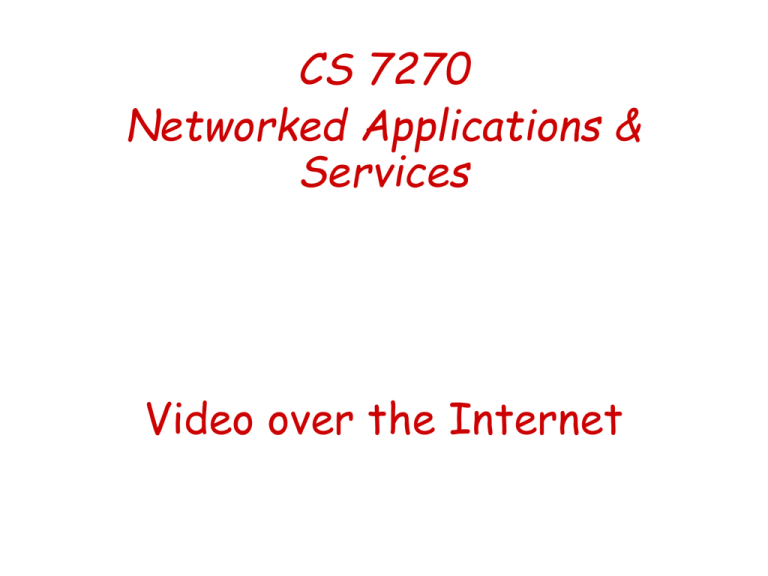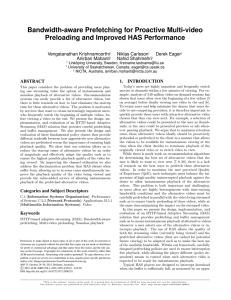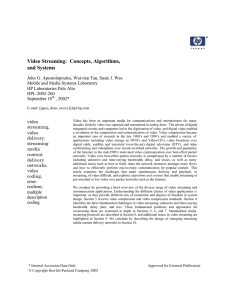Slides for lecture-2
advertisement

CS 7270 Networked Applications & Services Video over the Internet Reading • “Video Streaming: Concepts, Algorithms,and Systems”, John G. Apostolopoulos, Wai- tian Tan, Susie J. Wee, HP Laboratories Palo Alto • Very nicely written tutorial • But written in 2002 Classification of video apps • Point2point vs multicast vs broadcast – Is there a “reverse channel”? – Pros and cons of reverse channel • Real-time vs pre-recorded video – What about “almost real-time”? • Interactive vs non-interactive video • Static vs dynamic channels • CBR vs VBR channels – Do not confuse with CBR/VBR encoding • Packet-switched vs circuit-switched channels • QoS support? Overview of video compression • Distinguish between standards (e.g., MPEG-2) and particular codecs (e.g., WMV) • Spatial redundancy in images/video • Temporal redundancy in video • Perceptual redundancy (much less understood and exploited) JPEG image compression • Convert RGB image to luminance (intensity) and chrominance components • Partition image in 8x8 blocks • Compute 2-D Discrete-Cosine Transform (DCT) coefficients of each block – Natural images have mostly low-frequency content • Quantization of most important coefficients • Variable-length encoding (remember Huffman coding?) of quantized coefficients to produce compressed bitstream Video compression • Apply image compression for each frame? – Does not exploit temporal redundancy • Motion estimation • Partition frame in 16x16 blocks • Identify closest block in previous frame, and compute motion vector • Encode the prediction error, as well as the motion vector for each block Prediction dependences between frames • Intracoded frames (I), predicted frames (P), and interpolated frames (B) • Inherently VBR encoding • The GOP and its significance Video standards • What do the standards specify? – Encode and decoder implementations? – Bit syntax? – Decoding process? Video streaming challenges • Video download or video streaming? – – – Let’s define carefully each option Consider the standard “navigation” requirements (pause, fast-forward, rewind, scene selection, etc) Which option is better? 1. Time-varying bandwidth 2. Delay jitter 3. Packet losses Time-varying bandwidth and rate control • What does rate control mean? – How would you do rate control? • Available bandwidth estimation and its application in rate control • Video streaming over TCP – TCP is a window (not rate) based transport protocol – TCP adjusts the window size based on AIMD congestioncontrol algorithm – Nevertheless, TCP is often used in video streaming, especially when receiver window is appropriately sized • How would you calculate the receiver window size to set the streaming rate at a certain value? • Video streaming over UDP – Congestion control? – TCP friendlyness Rate control techniques • Transcoding – Requires application-layer gateways • Multiple encodings of same file – Burden for the server (and potentially the user) • Scalable compression (or layered coding) Jitter (delay variations) • Why is this a problem? • Solution: Playback buffering – Key question: how long should the playback buffer (or playback delay) be? – Several research proposals for Adaptive Playback Buffer schemes • Playback buffers have additional advantages: – Allow retransmissions of lost packets – Smooth throughput variations (e.g., due to TCP) – Loss resilience through interleaving Effect of playout buffering Packet losses • • 1. 2. 3. 4. – • • • Common in Internet paths due to congestion or short-term outages Key characteristic: losses take place in bursts Solutions? Retransmissions Commonly used, but constrained by delay budget and playback delay Forward Error Correction Introduce bandwidth overhead (and potentially delay) Loss/error concealment Less effective in highly compressed video, but also commonly used Loss resilient video coding Need for loss-resilient codecs • Some video codecs are not resilient to losses – Loss of bitstream synchronization • Need for Resync markers (placed where?) • Place most important data just after markers – Error propagation across frames • How can reverse channel help? Error-resilient video coding methods • Scalable (layered) video coding – Base layer plus several enhancement layers – Useful if network provides several classes of service or priorities • Multiple description coding (MDC) video – – – – Several “descriptions” of the same video The more descriptions you receive, the better Significant redundancy among descriptions What if all descriptions are subject to simultaneous losses? • MDC video with path diversity Multiple description video and path diversity Adaptive video streaming over HTTP • Read: – “Watching Video over the Web, Part 1 (streaming protocols”, by Ali Begen et al. Reading • “I Tube, You Tube, Everybody Tubes: Analyzing the World’s Largest User Generated Content Video System”, by M.Cha et al. • Appeared at IMC’07 YouTube basics • How can we crawl all posted videos? • Metadata for each video? – – – – – – # of views # of ratings Average rating (stars) # comments -> user interaction Links from other sites Director • Several categories of videos – The paper focuses on ENTertainment and “How to & DIY” (SCI) categories UGC vs non-UGC traces Pareto principle in video popularity • • • • Also known as the “80-20” (or 90-10) rule Associated with highly skewed distributions Caused by positive-feedback effects (“the rich get richer”) Does non-UGC content (say movies from NetFlix) follow a similar pattern? • A practical implication of this skewness: caching works! Video popularity: power-law? • Definition of power-law: Prob[X>x] ~ c*x-a for large x • How would you check if a random variable X follows a power-law? • The popularity of YouTube videos appears to be a power-law with an exponential cutoff in very large values (truncated tail) What causes the “truncated-tails”? • Authors’ conjecture: truncated tails can result from “fetch-only-once” effect? – As opposed to “fetch-again”, every time we access a popular Web page such as CNN.com Analysis of “long tail” phenomemon • 1. What can prevent/reduce the “long tail” effect for unpopular videos? 2. 3. Natural reasons: some video clips were not meant to be seen by many people (e.g., family or friend videos) Sampling filters: Uploaders do not post their less interesting videos Information filters: Search engines return most popular/linked content (older videos are more affected by such filtering) Do users mostly see new content? • Very recent videos (about a month old) get more requests • But overall, the popularity does not seem to depend on the video’s age Content duplication/aliases • What does this mean? • Why is it important? • How to detect aliases, say in YouTube? Illegal uploads of video content • Mostly due to copyrighted material • Major issue for all UGC applications • How to detect/measure? • The paper reports that only 5% of the deleted videos were marked by YouTube as “copyright violations”





